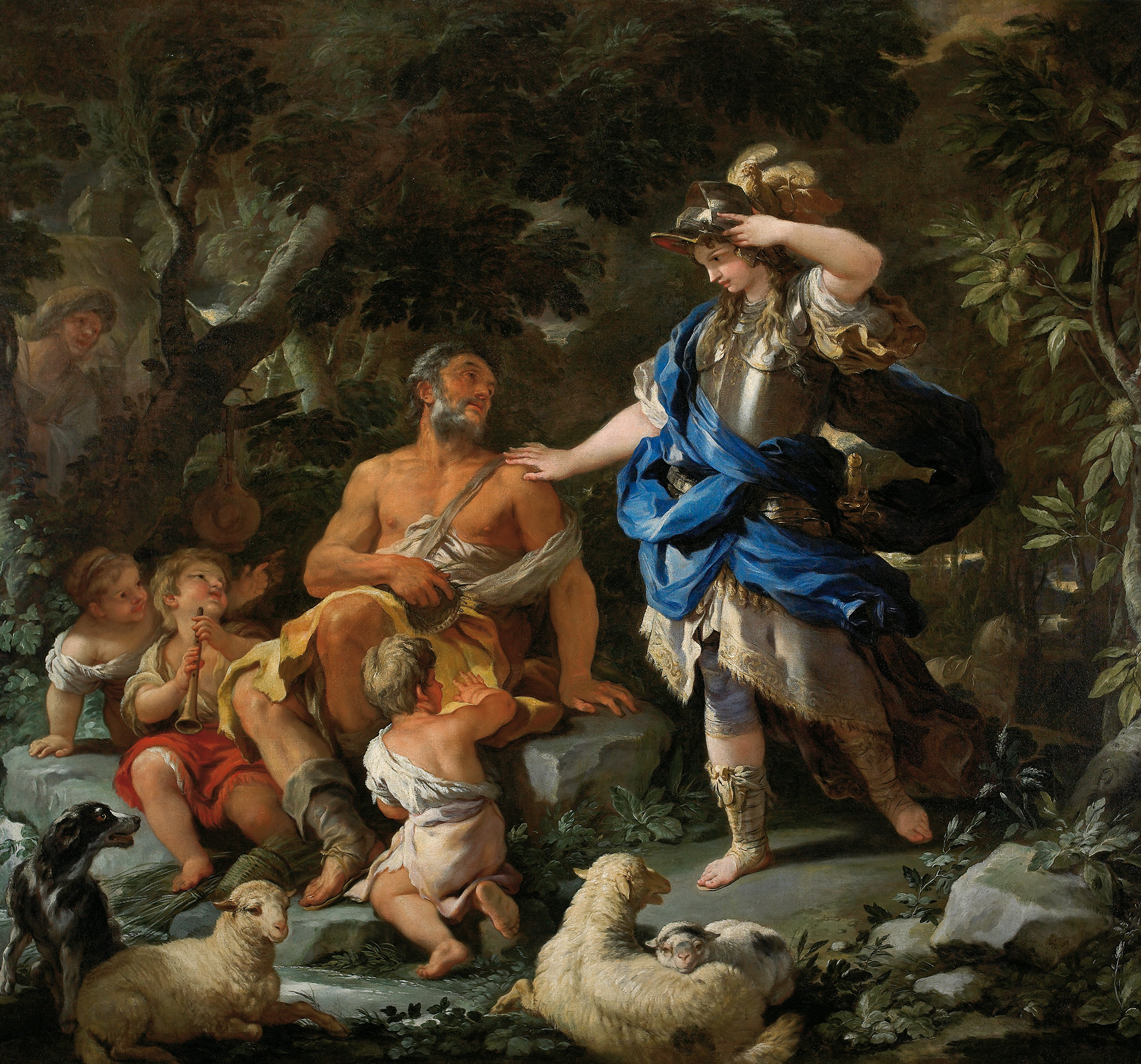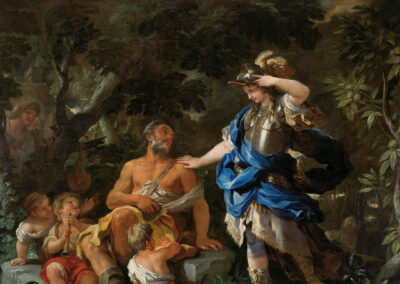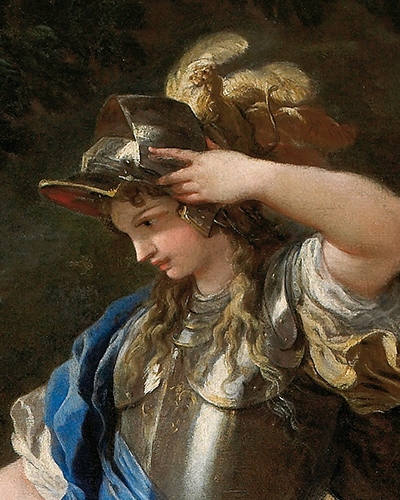The painting "Erminia and the Shepherds" by the Neapolitan painter Luca Giordano, better known in Spain as Lucas Jordán, comes from the extraordinary collection of works by this painter formed by the (9th) Count of Santisteban, among which were particularly famous twelve canvases, including this one, on scenes from Torcuato Tasso's Gerusalemme Liberata (1581), one of the most popular epic poems of the late Renaissance and Baroque periods throughout Europe.
Francisco de Benavides Dávila y Corella, 9th Count of Santisteban, came from an old family distinguished for its services to the Crown, a path he himself followed. His official CV began with the Captaincy General of the Kingdom of Granada (1672-5), followed by the Viceroyalty of Sardinia (1676-8), the Viceroyalty of Sicily (1678-87) and finally the Viceroyalty of Naples (1687-96). In all these posts, Santisteban left a mark of authority and good government. However, nothing seems to indicate that he was initially particularly attracted to the fine arts.
His father, Don Diego de Benavides, was a notable military officer and diplomat - minister plenipotentiary at the Peace of the Pyrenees - and ended his life as Viceroy of Peru; he was also a poet and an outstanding Latinist, author of an anthology of poems and moral reflections entitled Horae Succisivae, which his sons published posthumously, but there is nothing to indicate that he had any interest in art either. The formation of an important collection of paintings by Don Francisco de Benavides, as we shall see, was inherent to his Italian and, more specifically, Neapolitan experience.
Santisteban arrived in Naples in 1687 to replace the Viceroy Marquis del Carpio who had died in the city. Carpio, who was a compulsive purchaser of paintings whose collection achieved a European reputation, had already used his previous posting as ambassador to Rome to increase his gallery and in the four short years he spent in Naples he continued the process. He spent so much money that when he died his executors had to organise auctions of his works of art for several years in order to pay off his debts. Among his collection, Lucas Jordán had been one of his favourite painters, owning 49 of his works; we now know, however, thanks to González Asenjo's research, that this frenzied buying spree was at least partly due to Charles II's commission to acquire up to 122 paintings by Giordano.
In any event, when Santisteban arrived in Naples he found himself ordered to continue the work to fulfil the King's commission and with a mass of paintings from the Carpio collection (including those by Giordano) in the process of being sold off. At first, however, Santisteban, who was more interested in bookish culture, came into contact with the city's literary circles, particularly that of Giuseppe Valletta, which had an impressive library of 18,000 volumes; here a gathering of Neapolitan intellectuals met, including Nicoló Caravito, Giuseppe Lucina and, above all, Gianbattista Vico. Santisteban joined the group, thus forming the embryo of what his nephew and successor, the (9th) Duke of Medinaceli, would later formalise under the title of the Academia Palatina.
But this group of intellectuals was sensitive to the fine arts: Valletta himself owned an important collection of antiquities and paintings and was a close friend of Giordano, whom, as de' Dominici says, he advised on abstruse iconographic questions. This double exposure of the Viceroy to the world of the fine arts - in contact with the group of Neapolitan intellectuals around Valletta, who defended them from a theoretical point of view, and a spectator of the massive sales of the Carpio collection - would lead him to a genuine immersion in the world of connoisseurship. The result was a collection of paintings, modest in comparison with the gigantic collections of Carpio or his own nephew Medinaceli, but of great quality and where Giordano reigned supreme, to the point that Santisteban would leave not only a group of his paintings, but also his self-portrait "..." to the entailed estate.for being of so eminent a man". Indeed, of the 121 works by various artists listed in the inventory drawn up in 1716 by Antonio Palomino, 62 were by Giordano, as well as a book containing 24 of his drawings.
Just as some of Giordano's paintings must have been acquired at sales in the Carpio collection, his twelve paintings on the theme of Gerusalemme Liberata were probably commissioned by Santisteban himself, who had in his library not only that work by Tasso but also the less popular Gerusalemme Conquistata of 1593 by the same artist. These twelve paintings, of different formats to adapt them to doors, window shutters, etc., hung together in the so-called "red podium"Antonio Palomino saw them there and praised them, as did Abbé Ponz and Count de la Viñaza later. The painting we are concerned with here, "Erminia and the Shepherds"follows almost literally stanze 6 and 7, from Book VII of the Gerusalemme Liberata, but Giordano has interpreted the passage in a very original way, giving the heroine almost childlike features, which gives the scene an air closer to the rococo than to the baroque.
Santisteban's discovery of the art of painting in his Neapolitan viceroyalty and the friendship that must have been established between the painter and the Viceroy would last until the painter's departure for the Court in 1692, the Viceroy being in charge of arranging the conditions of his new assignment in Spain; A letter from Santisteban to his nephew, the Spanish ambassador in Rome, the Duke of Medinaceli, dated 13 November 1693, shows him advising him on the procedure for sending other artists from Rome to Spain, based on his previous experience. However, once the Viceroy returned to Spain in 1696, friendships must have resumed; at least this is suggested by the family portrait of the Viceroy, in which the painter himself is also portrayed and which is now in the National Gallery, London.
Vicente Lleó Cañal, April 2009



